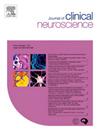Does optic nerve sheath fenestration alleviate headaches in patients with idiopathic intracranial hypertension? A retrospective study
IF 1.8
4区 医学
Q3 CLINICAL NEUROLOGY
引用次数: 0
Abstract
Objective
To evaluate headache course after optic nerve sheath fenestration (ONSF) in idiopathic intracranial hypertension (IIH) patients.
Methods
In this retrospective cohort study, IIH patients’ data who had undergone ONSF due to progressive visual field loss despite medical treatment or advanced visual field loss at onset, including age, sex, cerebrospinal fluid (CSF) opening pressure, laterality of ONSF (unilateral or bilateral), best corrected visual acuity (BCVA), visual field mean deviation (MD) preoperatively and after ONSF in the worse and fellow eyes, were noted. Headache severity assessed using the visual analog scale, and headache frequency defined as the number of headache days per month before and after surgery were considered.
Results
20 patients (17 females, 3 males) with a mean age of 32.4 years and a mean CSF opening pressure of 492.79 mm H2O were studied. ONSF was unilateral in 12 (60 %) and bilateral in 8 (40 %) patients. Median LogMAR BCVA and MD in the worse eye improved significantly after surgery (p = 0.04 and p = 0.02, respectively), whereas improvement in the fellow eye was not significant (p > 0.05). Though headache severity and frequency decreased after surgery (p = 0.01 and p = 0.001, respectively) it was still present in 12 patients (60 %). Age, sex, CSF opening pressure, uni/bilateral ONSF, BCVA or MD in the worse or fellow eye had no effect on the course of headache severity or frequency.
Conclusion
Specific headache treatment is essential in IIH, since lowering intracranial pressure by ONSF is not associated with headache relief in over half of the patients.
视神经鞘开窗是否能缓解特发性颅内高压患者的头痛?回顾性研究
目的评价特发性颅内高压(IIH)患者视神经鞘开窗术(ONSF)后的头痛病程。方法在本回顾性队列研究中,记录了IIH患者在接受药物治疗后因进行性视野丧失或发病时出现晚期视野丧失而行ONSF的资料,包括年龄、性别、脑脊液(CSF)开放压力、ONSF的侧边性(单侧或双侧)、最佳矫正视力(BCVA)、最差眼和同侧眼的视野平均偏差(MD)。使用视觉模拟量表评估头痛严重程度,并考虑头痛频率,即术前和术后每月头痛天数。结果20例患者(女17例,男3例)平均年龄32.4岁,平均脑脊液开口压492.79 mm H2O。12例(60%)为单侧ONSF, 8例(40%)为双侧ONSF。较差眼的中位LogMAR BCVA和MD在手术后显著改善(p = 0.04和p = 0.02),而同侧眼的改善不显著(p >;0.05)。虽然手术后头痛的严重程度和频率有所下降(分别为p = 0.01和p = 0.001),但仍有12例(60%)患者存在头痛。年龄、性别、脑脊液开口压、单侧/双侧ONSF、BCVA或伴眼MD对头痛的严重程度或频率无影响。结论:在IIH患者中,特异性头痛治疗是必要的,因为超过一半的患者使用ONSF降低颅内压与头痛缓解无关。
本文章由计算机程序翻译,如有差异,请以英文原文为准。
求助全文
约1分钟内获得全文
求助全文
来源期刊

Journal of Clinical Neuroscience
医学-临床神经学
CiteScore
4.50
自引率
0.00%
发文量
402
审稿时长
40 days
期刊介绍:
This International journal, Journal of Clinical Neuroscience, publishes articles on clinical neurosurgery and neurology and the related neurosciences such as neuro-pathology, neuro-radiology, neuro-ophthalmology and neuro-physiology.
The journal has a broad International perspective, and emphasises the advances occurring in Asia, the Pacific Rim region, Europe and North America. The Journal acts as a focus for publication of major clinical and laboratory research, as well as publishing solicited manuscripts on specific subjects from experts, case reports and other information of interest to clinicians working in the clinical neurosciences.
 求助内容:
求助内容: 应助结果提醒方式:
应助结果提醒方式:


